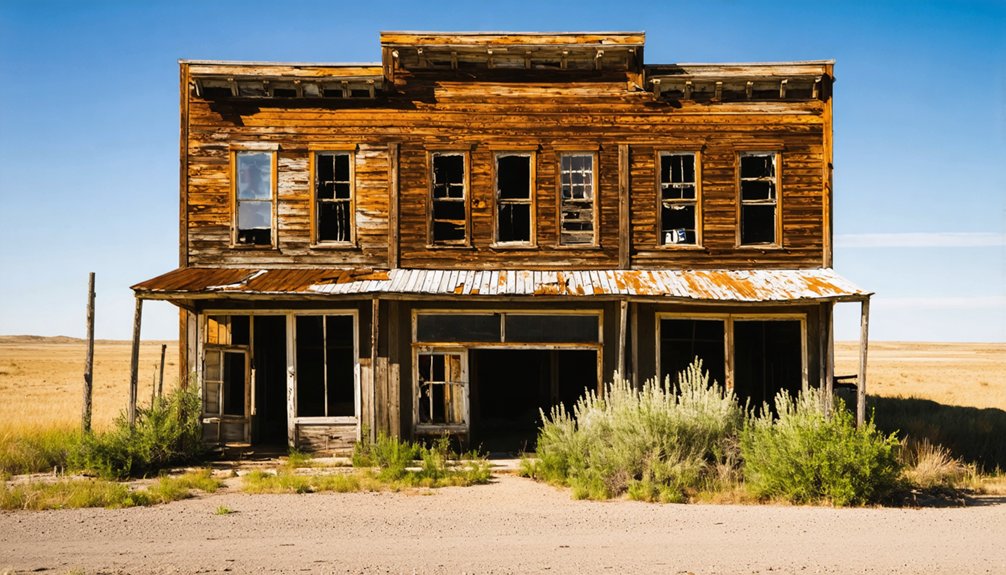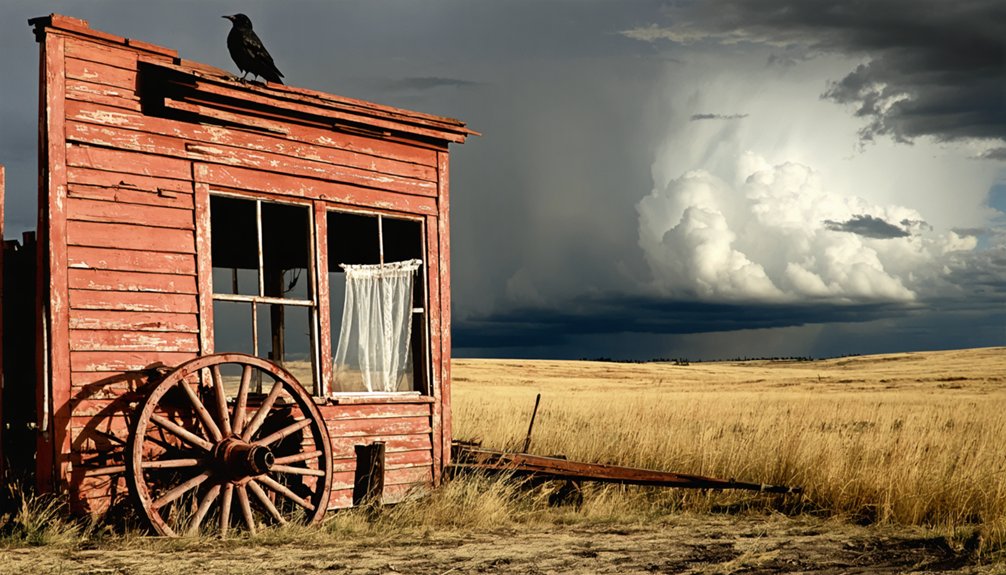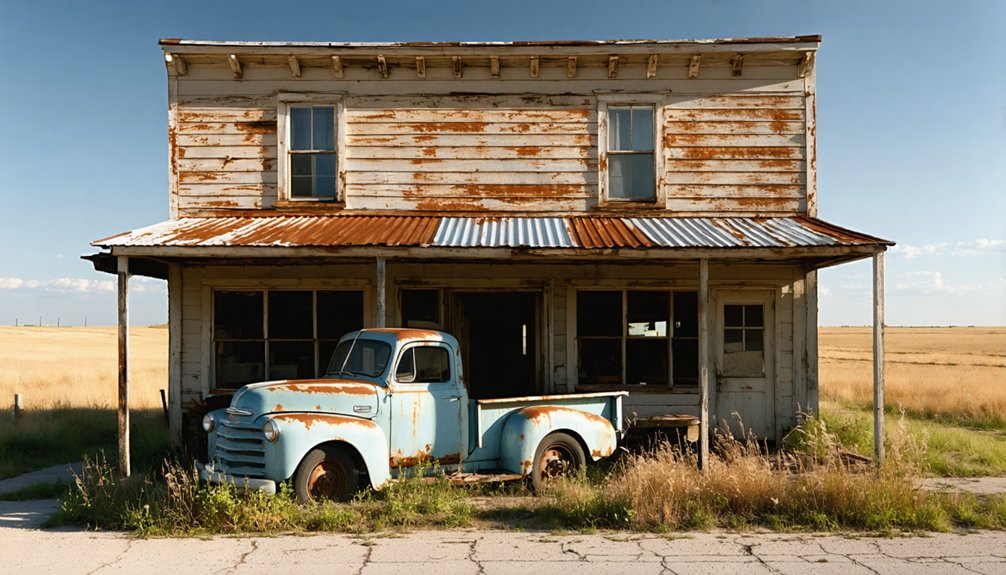You’ll find Redwater’s ghost town remains at 44°40’19″N and 103°50’41″W in South Dakota’s Butte County, where three waterways meet. This former mining settlement emerged during the 1870s Black Hills gold rush, thriving until the early 1900s through gold and mica production. The town’s wooden structures and mining artifacts still dot the rugged landscape near Spearfish, while the nearby Belle Fourche Clay Pit recalls the area’s rich industrial heritage. The site’s untold stories lie scattered among its weathered foundations.
Key Takeaways
- Redwater is a former mining settlement in Butte County, South Dakota, located at 44°40’19″N and 103°50’41″W at 914 meters elevation.
- The town emerged during the 1870s Black Hills gold rush, serving as a hub for independent prospectors and larger mining operations.
- Homestake Mining Company established crucial railroad connections through Redwater for transporting ore and supplies.
- The town’s economy was based on mining activities, producing significant mineral wealth including 1.5 million pounds of mica annually.
- Today, weathered remnants of mining-era structures, building foundations, and mining artifacts remain scattered across the landscape.
Location in the Black Hills Region
Nestled in the northern slopes of South Dakota’s Black Hills, the ghost town of Redwater sits at coordinates 44°40’19″N and 103°50’41″W in Butte County.
You’ll find it perched at an elevation of 914 meters, where geographical features include a critical drainage divide between the Redwater River and Spearfish Creek.
The site’s historical significance stems from its position near the confluence of three major waterways: the Belle Fourche River, Redwater River, and Hay Creek.
The area’s rich mining heritage is evident in the nearby Belle Fourche Clay Pit, located just 6.6 kilometers away.
You’re just a short drive from Belle Fourche city, and you can access the area via Chicken Run County Road north of Spearfish.
The town’s location showcases the dramatic shift where the Black Hills’ rugged terrain rises from the surrounding Great Plains, marked by ancient rock formations and deep valleys shaped by centuries of erosion.
The landscape bears evidence of massive southeast-oriented floods that carved through the region during periods of rapid glacial melting.
Mining Era and Economic Roots
During the 1870s Black Hills gold rush, you’d find Redwater among the mining settlements that sprang up as prospectors and mining companies sought to extract gold from the region’s rich deposits.
Following the Treaty of Fort Laramie violation, miners flooded into the region despite its protected status as part of the Great Sioux Reservation.
When the Homestake Mining Company expanded its operations, they established essential railroad connections through Redwater to transport ore and mining supplies more efficiently.
The town’s economic foundation rested heavily on serving both independent prospectors and larger mining operations, following similar patterns seen in other Black Hills communities like Lead and Deadwood. Beyond gold, the area contributed to America’s mineral wealth through extensive mica production, reaching 1.5 million pounds annually between 1906 and 1911.
Mining Operations and Scale
Located in the mineral-rich Black Hills mining district, Redwater’s story closely intertwined with South Dakota’s gold mining boom of the late 19th and early 20th centuries.
The geology mirrored that of the Lead District, containing important Precambrian rock formations that would prove highly productive.
You’d find a range of mining techniques being employed, from early placer mining to sophisticated hardrock operations that tapped into the area’s Precambrian ore bodies.
The scale of production was impressive, with mining companies like Homestake, Wasp No. 2, and Golden Reward leading the charge.
Homestake dominated the landscape, extracting over 40 million ounces of gold during its 120-year run. The Mascot mine contributed 43,885 ounces between 1892 and 1937.
Mining operations expanded beyond simple extraction, incorporating advanced chlorination and cyanidation methods, while building extensive infrastructure including railroads and timber operations to support their ambitious ventures.
Gold Rush Economic Impact
When the Black Hills Gold Rush ignited in 1874 following Custer’s Expedition, Redwater’s economic foundations were set into motion alongside the broader region’s change.
You’ll find that prospector stories from this era tell of ambitious fortune-seekers who first worked the creek beds for loose gold flakes before shifting to industrial-scale mining operations. The discovery of the Homestake Mine in 1876 revolutionized the region’s mining industry by producing an astounding tenth of the world’s gold supply. George Hearst’s investors paid $70,000 to acquire the lucrative claim.
The economic migration brought waves of skilled and unskilled laborers, merchants, and investors who transformed the area from a subsistence economy into a wage-based market system.
Outside capital, particularly from San Francisco financiers, poured into the region to establish sophisticated mining operations.
This investment didn’t just fuel gold extraction – it sparked the growth of timber industries, transportation networks, and merchant enterprises that would sustain the Black Hills’ economic ecosystem for decades to come.
Railroad Connection Effects
As the Black Hills mining industry expanded in the 1880s, Redwater’s connection to the region’s railroad network proved transformative for its economic development.
You’ll find that railroad benefits extended far beyond simple cargo movement – they revolutionized the entire mining operation’s efficiency. The railways provided year-round access to essential supplies, heavy equipment, and new markets that would’ve been impossible to reach otherwise.
Transportation efficiency dramatically improved when narrow-gauge lines began serving the area’s mines, allowing companies to haul timber, machinery, and ore with unprecedented speed. The region’s mines benefited from agricultural freight revenue, which made up over 26% of railroad earnings in the area.
You could see this impact through the growth of nearby settlements, as the railroad brought steady streams of mining supplies, food, and consumer goods that sustained both the industry and its workforce.
The rail system fundamentally became Redwater’s lifeline to the outside world. The arrival of the Fremont, Elkhorn railroad in 1890 marked a crucial turning point for regional development.
Railroad’s Rise and Decline
You’ll find Redwater’s railway history intertwined with the Chicago and North Western Railroad, which established a critical junction point there in the late 1800s.
Following the Transcontinental Railroad completion in 1869, railway expansion accelerated throughout the region.
The town’s fortunes shifted dramatically when the railroad realigned its tracks in the early 1900s, bypassing what had been a bustling terminal operation.
After the track changes, Redwater’s role as a railway hub diminished rapidly, and terminal operations eventually ceased altogether, dealing a severe blow to the town’s economic foundation.
Railway Junction Development
Throughout South Dakota’s early development, railroad junctions emerged as essential economic centers that transformed sparsely populated areas into thriving commercial hubs.
You’ll find that these strategic intersections became significant for railway logistics, connecting multiple rail lines and facilitating efficient movement of goods and passengers across the territory.
The junction economics sparked remarkable growth, as towns positioned at these crossroads attracted critical businesses like hotels, warehouses, and repair facilities.
You can see how some communities, such as Parkston, even relocated entirely to capitalize on rail access.
Railroad companies fiercely competed for control of these junctions, recognizing their importance in the region’s transportation network.
Major players like Milwaukee Road and Chicago and North Western Railway invested heavily in infrastructure, building bridges and trestles to maximize their junction operations.
Track Realignment Impact
When major railroad companies began realigning their tracks in South Dakota during the early 1900s, the decisions reshaped the economic destiny of numerous settlements.
You’ll find that track alterations, driven by Chicago, Burlington and Quincy Railroad and Chicago and North Western Railroad mergers between 1903-1907, led to widespread economic displacement throughout the region.
Communities like Redwater faced stark choices when railroads bypassed their locations. You couldn’t fight the railroad companies’ priorities – if they deemed your route inefficient, they’d simply redirect traffic elsewhere.
Some towns, like Parkston, survived by physically relocating to meet the new rail lines. Others, unable to adapt, saw their businesses close and populations dwindle.
Rail access meant survival, and when the tracks moved, towns often died.
Terminal Operations Ceased
The decline of railroad terminal operations in Redwater mirrored a broader post-World War II pattern across South Dakota.
You’ll find that as automobiles and trucks gained dominance, the once-bustling rail terminals that served as community lifelines began shutting down. Terminal closures led to economic isolation, forcing residents to adapt or relocate.
- Rail companies shifted away from serving smaller communities like Redwater, prioritizing major routes and long-haul freight.
- The loss of terminal operations meant the end of essential services – mail delivery, grain shipments, and telegraph communications.
- Rising maintenance costs and declining revenues made it impossible to sustain operations, despite temporary state interventions like sales tax increases.
The impact was devastating – without its role as a transport hub, Redwater’s community fabric unraveled, ultimately contributing to its ghost town status.
Daily Life in Early Redwater
Life in early Redwater centered around modest wooden frame houses and log cabins that dotted the landscape near the confluence of Redwater and Belle Fourche Rivers.
You’d find thick-walled homes with small windows built to withstand harsh winters, often insulated with sod or earth. Daily routines revolved around seasonal farming and ranching tasks, from tending thoroughbred horses to harvesting alfalfa.
Community gatherings brought settlers together at churches and community halls, where you’d experience dances, auctions, and church services.
From barn dances to Sunday sermons, settlers found their social heartbeat in the shared spaces of early Redwater.
You’d preserve your food through smoking, salting meat, and root cellaring vegetables for winter survival.
The arrival of the railroad in 1890 transformed life here, connecting you to larger markets and making travel easier than the previous stagecoach-only days.
Remnants and Historical Sites

Modern visitors to Redwater can still spot weathered remnants scattered across the landscape, offering glimpses into its mining-era past.
You’ll find traces of miners’ cabins, building foundations, and rusted dredge barge ribs near Castle Creek. Historic remnants exploration reveals metal equipment deteriorating underwater and ash heaps marking former dwelling sites.
- Large dredge tailings and mining waste piles stand as silent witnesses to past operations.
- Mining artifacts like tools, rails, and processing equipment remain frozen in time.
- Building foundations and partial walls outline where businesses once thrived.
The area’s historical preservation needs have left some structures intact, including nearby churches and industrial buildings that paint a picture of this once-bustling Black Hills mining community.
Former wagon trails and quarry sites add depth to Redwater’s visible heritage.
Population Changes Through Time
As Minnesela first took shape in 1876, pioneers established a modest settlement that would later become officially founded as a town in 1882. The initial population dynamics showed about 100 residents, with the town serving as Butte County’s first seat.
Settlement patterns shifted dramatically when the railroad bypassed Minnesela in 1890, choosing Belle Fourche instead. You’ll find that this single decision sealed the town’s fate.
The population steadily declined as residents sought better economic opportunities in more connected communities. While some South Dakota towns experienced dramatic booms of over 1,000 people during mining rushes, Minnesela’s decline proved swift and permanent.
Cultural Heritage and Social Stories

The mining town of Redwater emerged from the rugged Black Hills landscape as more than just an industrial outpost – it became a vibrant community shaped by diverse cultural influences.
The town’s cultural narratives centered on the daily rhythms of mining life, where social bonds formed in saloons, churches, and community halls. Through oral histories and folklore preservation efforts, you’ll discover a rich tapestry of stories about colorful characters and dramatic events that defined frontier life.
- Tales of mining accidents, mysterious disappearances, and encounters with legendary figures like Wild Bill Hickok
- Social chronicles of immigrant miners, frontier women, and fortune seekers who shaped the town’s character
- Living memories preserved through artifacts, mine ruins, and documented accounts of boom-and-bust cycles
Modern-Day Ghost Town Status
Standing silent amid the western South Dakota plains, Redwater exemplifies a classic Black Hills ghost town where abandoned buildings tell stories of a forgotten frontier community.
You’ll find weathered structures and old foundations scattered across the site, though most lack roofs and proper maintenance. While ghost town tourism draws curious visitors to South Dakota’s abandoned settlements, Redwater remains largely uncommercialized and faces significant preservation challenges.
You won’t find any permanent residents here today – just occasional visitors exploring the remnants of what once was.
The remote location has kept modern development at bay, but it’s also made restoration efforts difficult. The buildings continue their slow dance with decay, gradually returning to the prairie as nature reclaims this piece of frontier history.
Frequently Asked Questions
What Dangerous Wildlife Can Visitors Encounter Near the Redwater Ghost Town Site?
You’ll need wildlife safety awareness for black bears, mountain lions, bison, rattlesnakes, black widow spiders, and brown recluse spiders—all capable of dangerous animal encounters near the site.
Are There Any Reported Paranormal Activities or Ghost Sightings in Redwater?
You won’t find documented ghost stories or haunted locations specific to Redwater. While nearby Black Hills ghost towns have paranormal reports, Redwater itself lacks credible accounts of supernatural activity.
Can Metal Detecting or Artifact Collecting Be Done Legally at Redwater?
You’ll need proper permits for any artifact collecting – 90% of ghost towns require landowner permission. Metal detecting regulations and collecting guidelines mandate written authorization before searching this historically protected site.
What Natural Disasters or Events Contributed to Redwater’s Abandonment?
You won’t find direct evidence of flood impacts or drought effects causing Redwater’s abandonment. Instead, the town’s decline came from typical mining town economic factors rather than sudden natural disasters.
Are There Any Seasonal Festivals or Events Celebrating Redwater’s History?
You’ll find historical reenactments and local art showcased at nearby Deadwood’s events, but Redwater doesn’t host its own dedicated festivals. You can experience regional history through Black Hills Powwow and Days of ’76.
References
- https://www.youtube.com/watch?v=Glucs_Rq8Xs
- https://www.sdhspress.com/journal/south-dakota-history-2-2/some-black-hills-ghost-towns-and-their-origins/vol-02-no-2-some-black-hills-ghost-towns-and-their-origins.pdf
- https://www.sdpb.org/rural-life-and-history/2023-08-21/some-black-hills-ghost-towns-and-their-origins
- https://en.wikipedia.org/wiki/List_of_ghost_towns_in_South_Dakota
- https://history.sd.gov/preservation/docs/RuralButteMeadeCo.pdf
- https://b1027.com/south-dakota-has-an-abundance-of-ghost-towns/
- https://973kkrc.com/south-dakota-underwater-ghost-town/
- https://kxrb.com/ixp/485/p/south-dakota-underwater-ghost-town-2/
- https://www.mindat.org/feature-5768346.html
- https://geomorphologyresearch.com/2011/12/20/redwater-river-spearfish-creek-drainage-divide-area-landform-origins-black-hills-region-western-south-dakota-usa/



